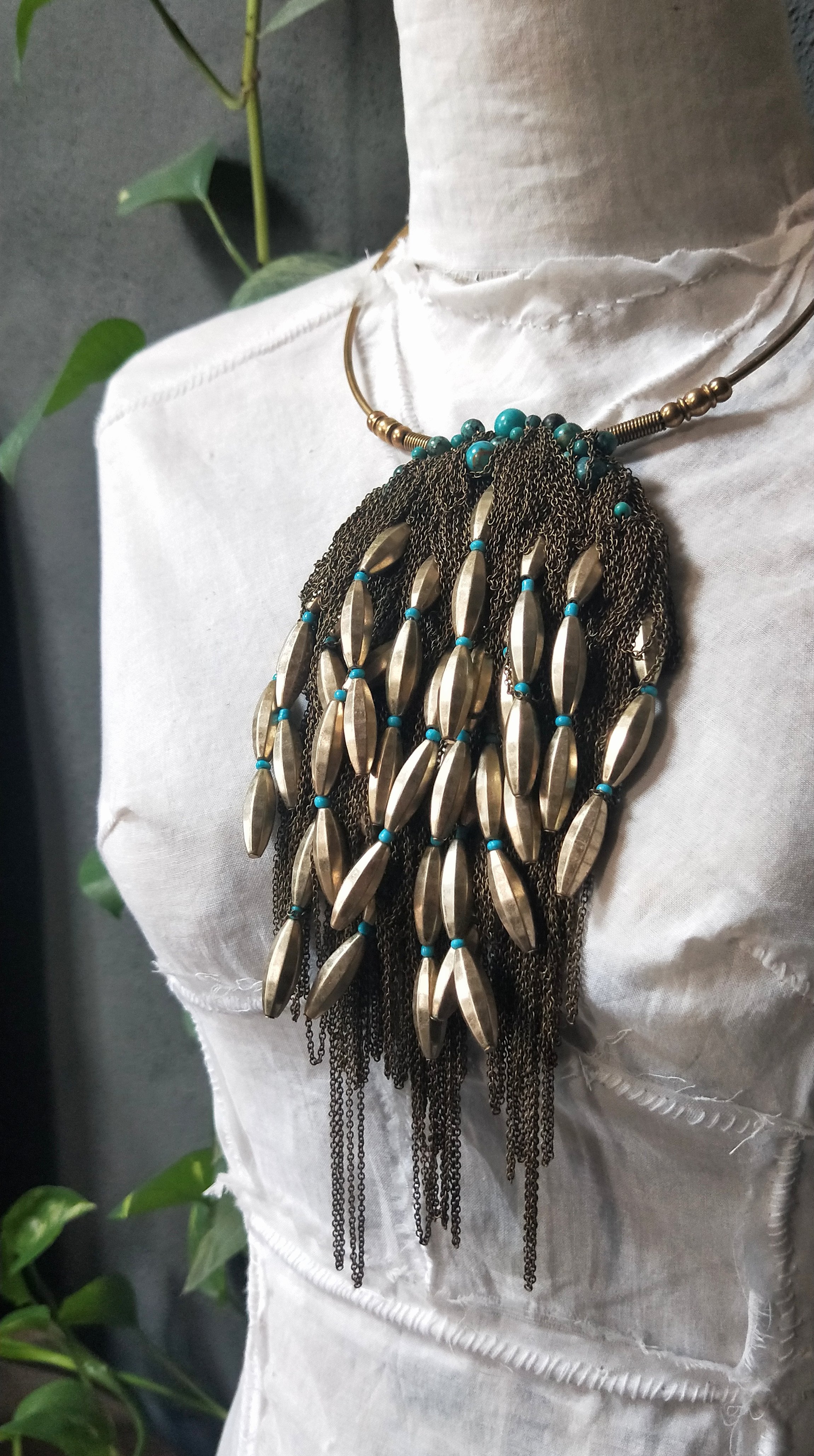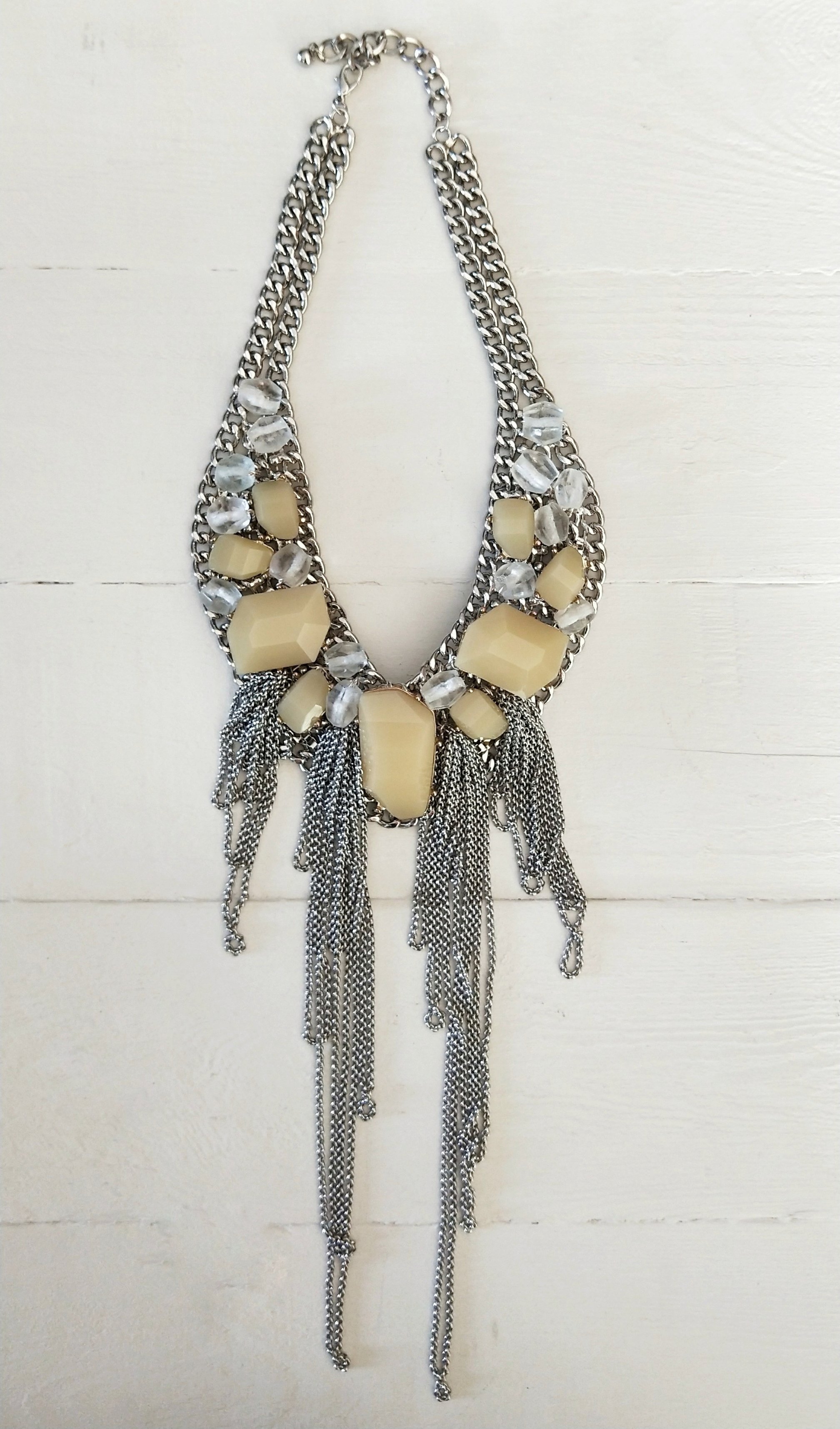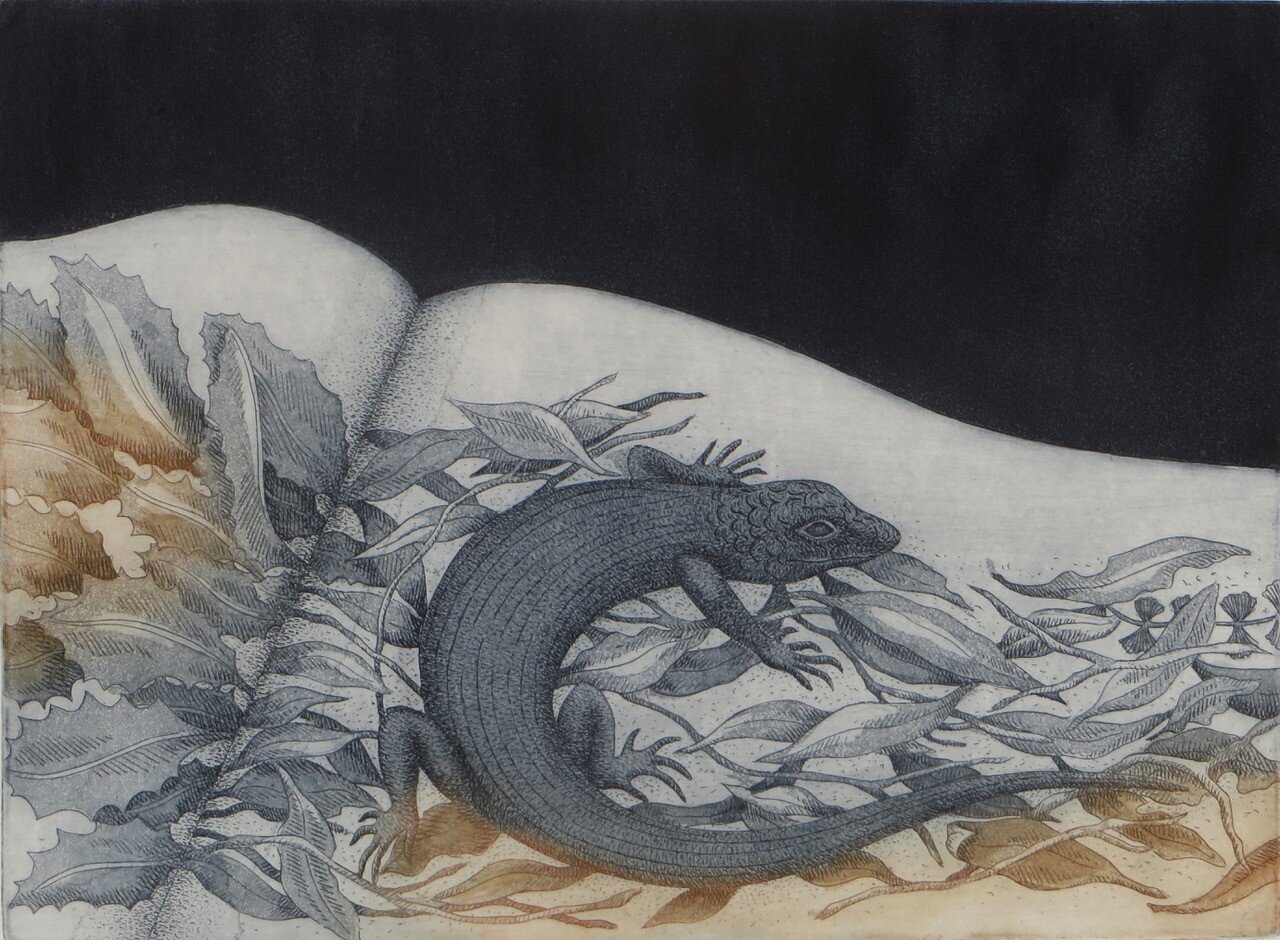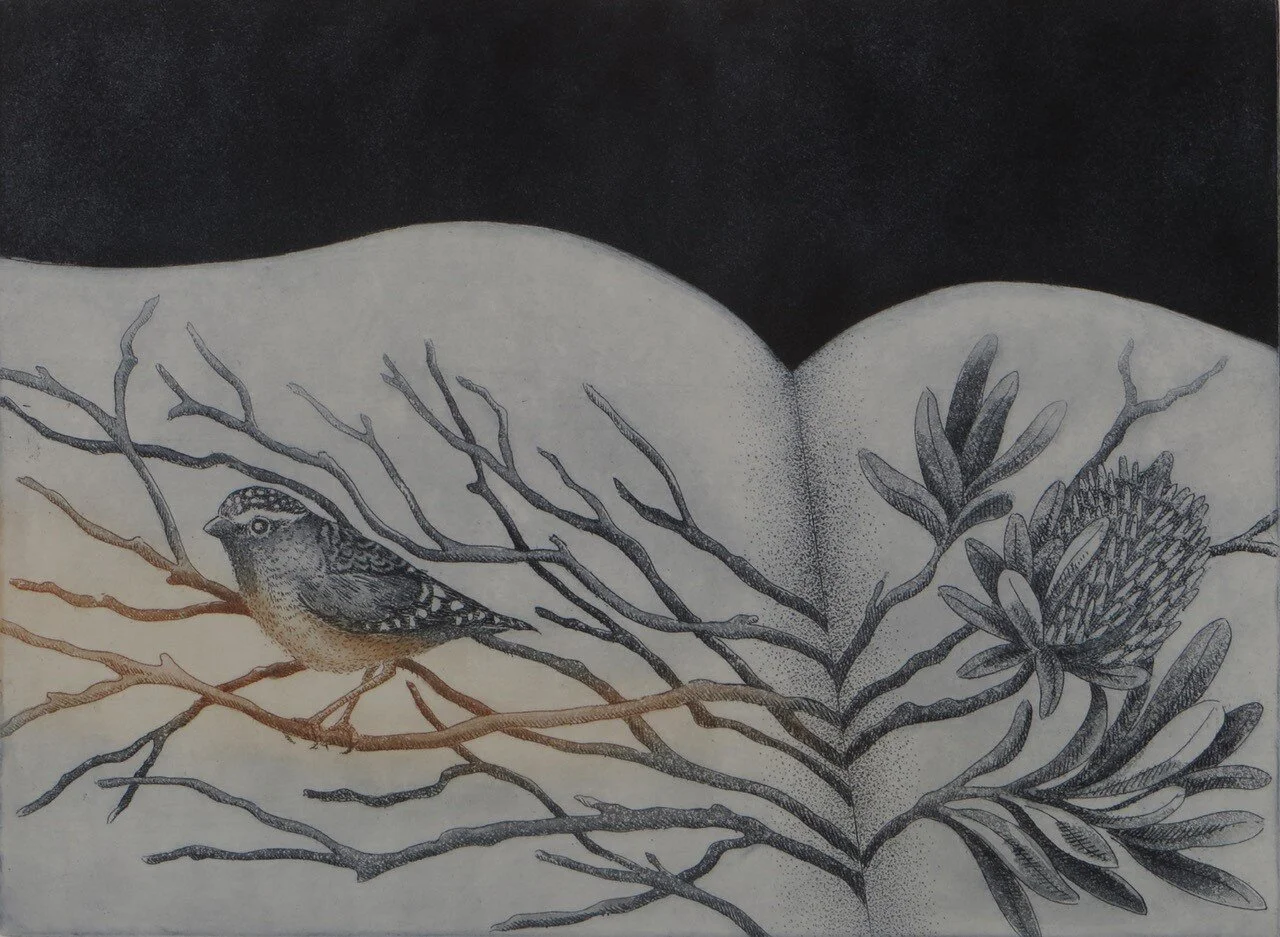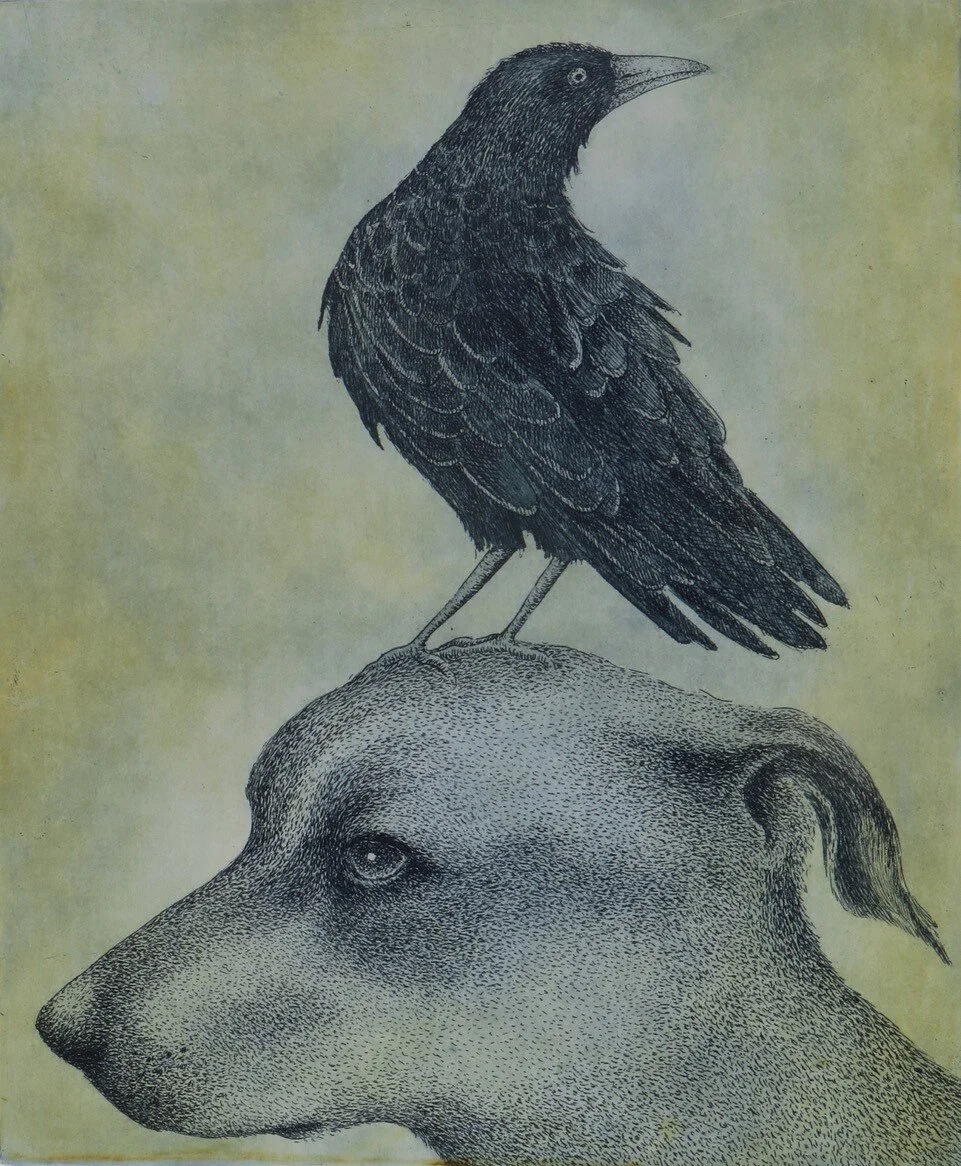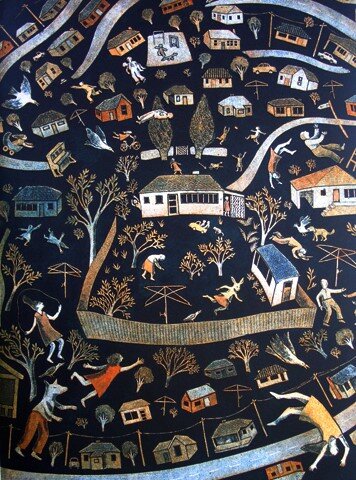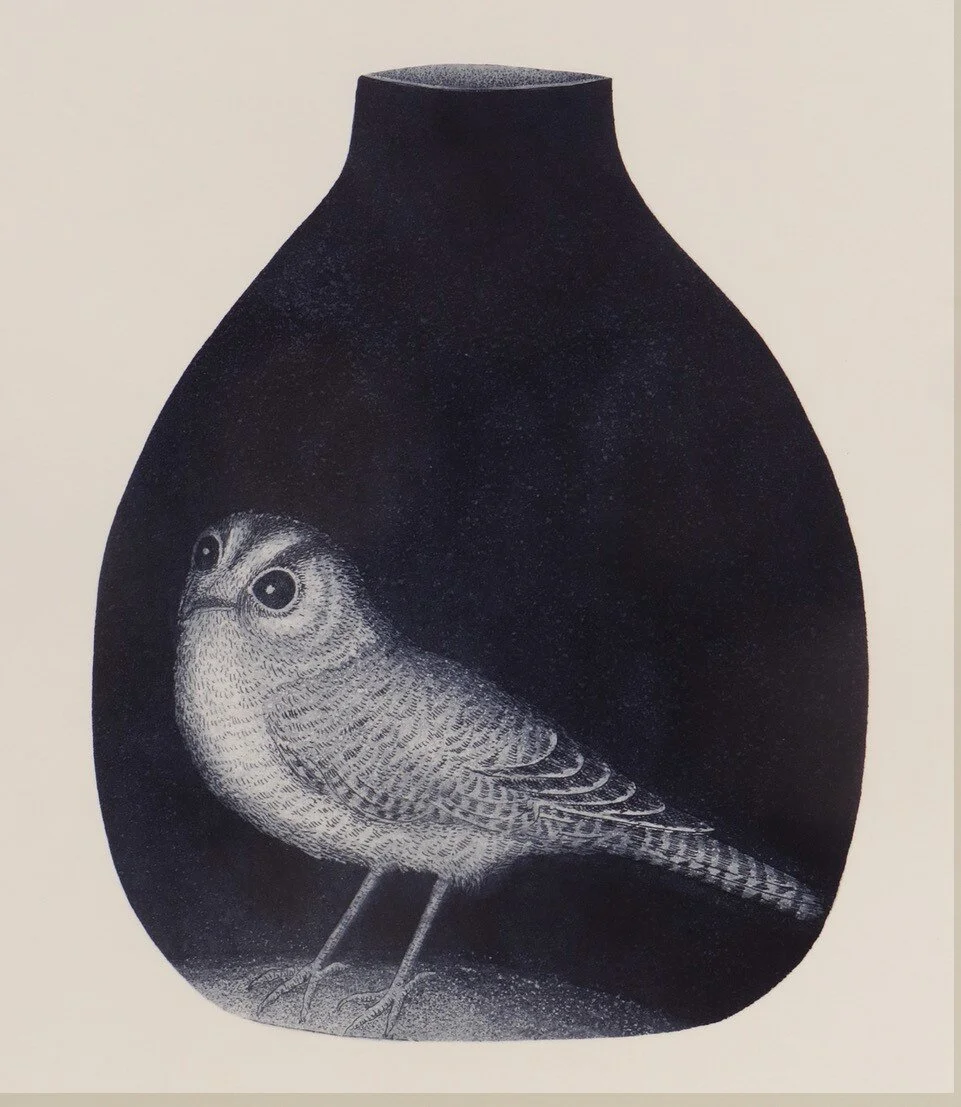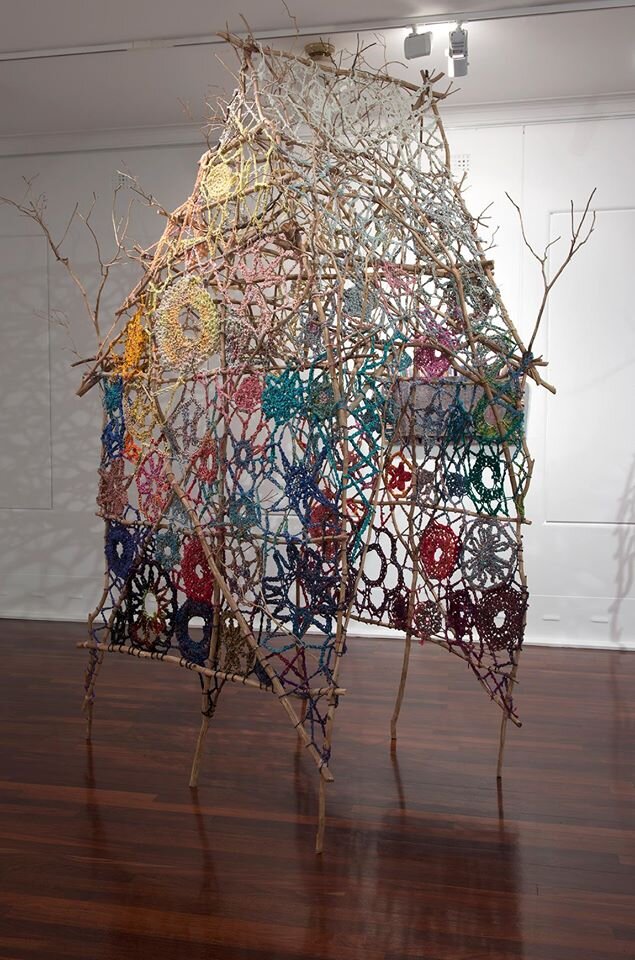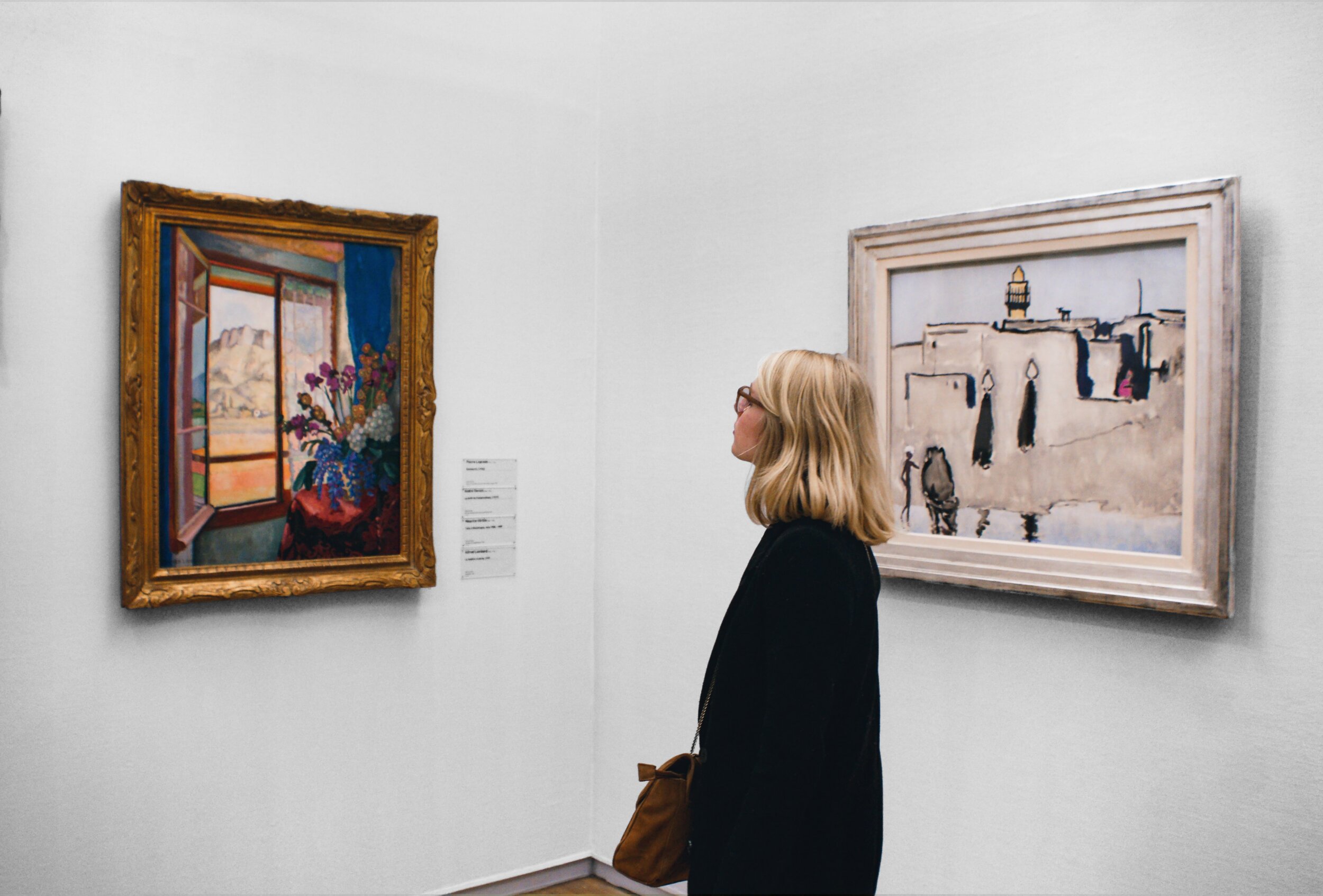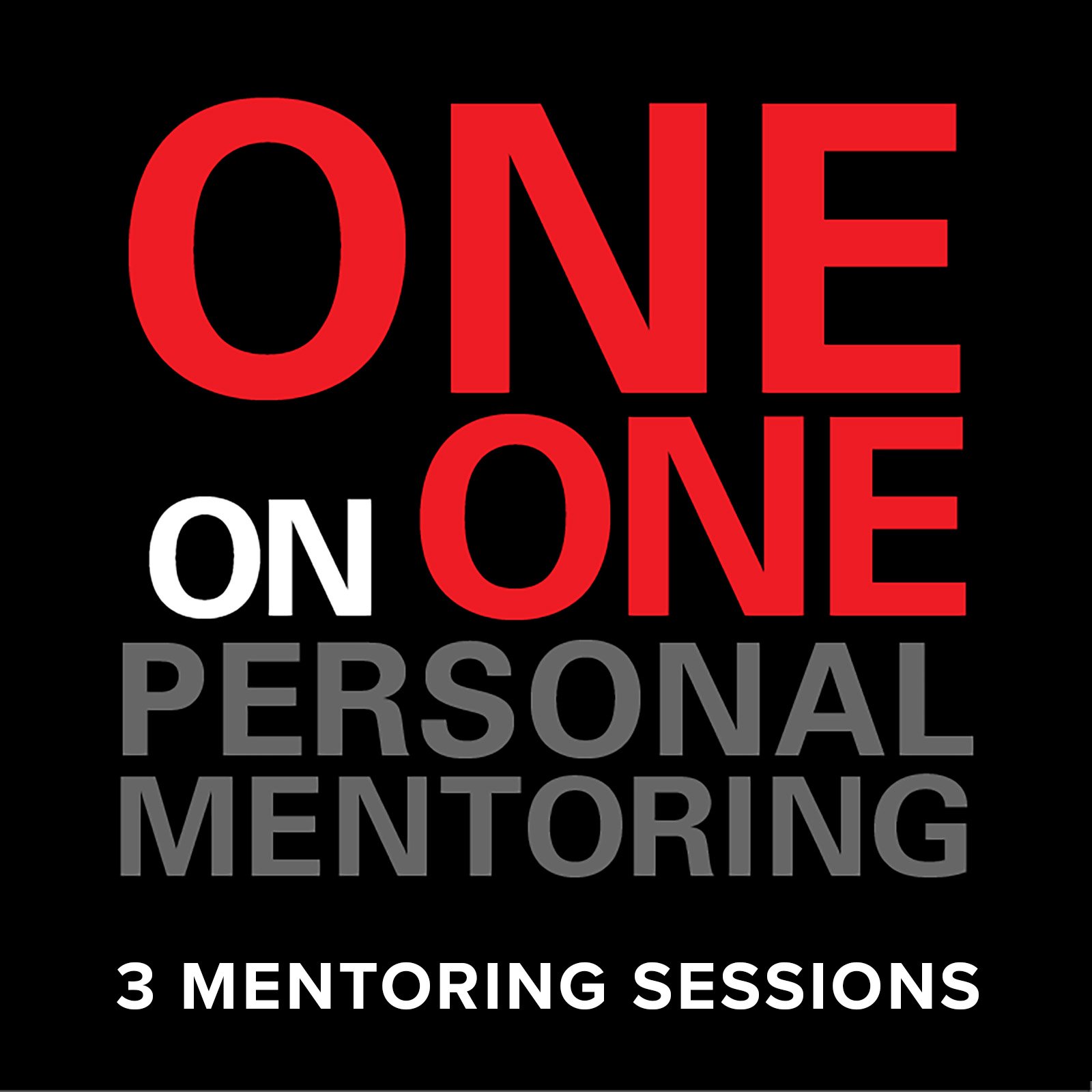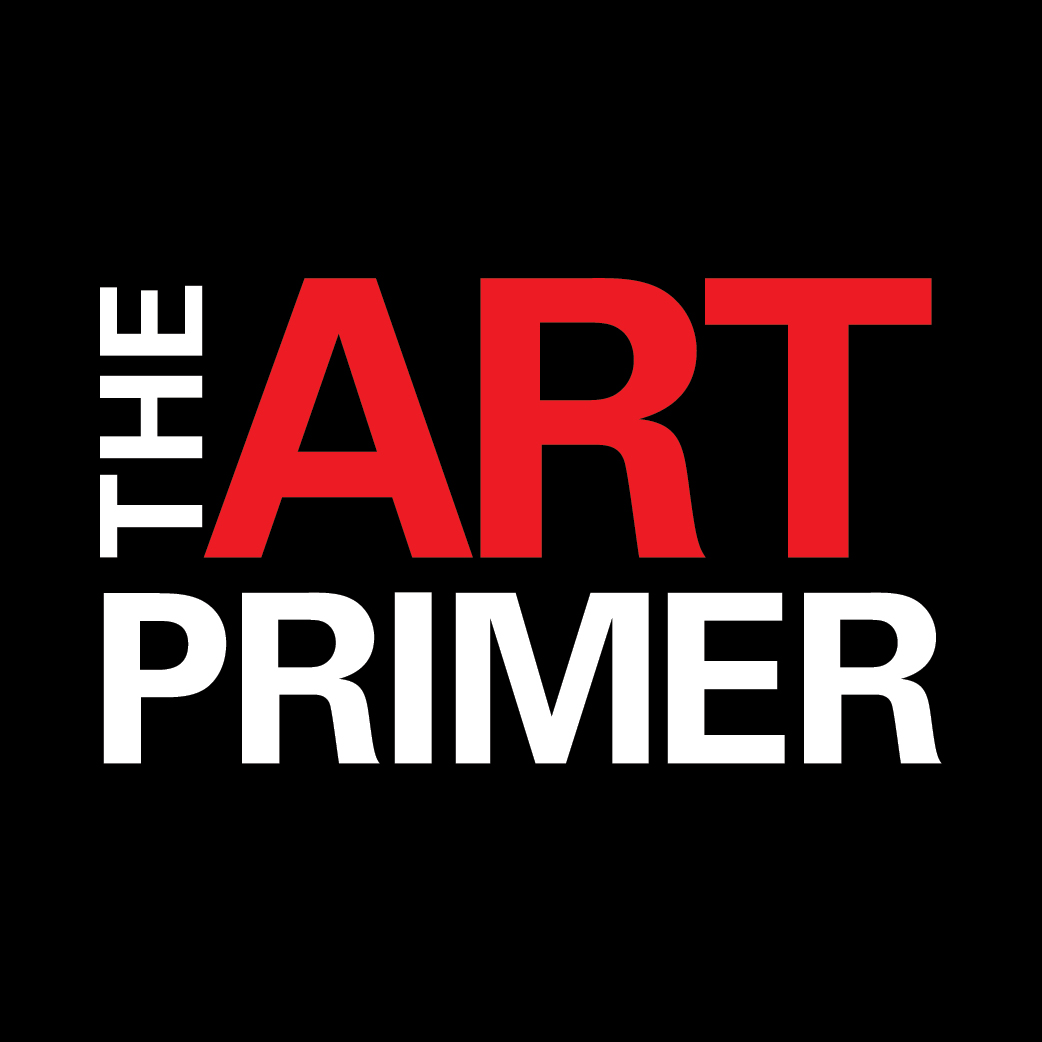
FOLLOWING THE BLACK LINE
Focus on Julie Holmes-Reid of Meraki Designs
Julie Holmes-Reid of Meraki Designs repurposes discarded materials into stunning jewelry, drawing inspiration from high fashion and her treasure trove of op shop finds. Her pieces are unique amalgamations, meticulously reconstructed until they achieve perfection, embodying both sustainability and artistic innovation.
Cultivating beauty from ingredients destined for the tip is central to Meraki Designs, the practice of designer-maker, Julie Holmes-Reid.
Julie’s practice is unconstrained; the usual and expected ingredients are completely absent in her jewellery and objects.
She recycles. Costume jewellery and any material or element that has promise is taken apart and give new life. Chains, plastic, faux pearls, glass beads.
“There’s mountains of material out there and so much beauty”.
High fashion and runway jewellery inspire her; the aesthetics of Schiaparelli, Lanvin, Christian Lacroix, Gucci, Gaultier and Valentino. Yet, her own treasure trove and stockpile is at the other end of town. Op shops.
Unlikely materials uncovered then recycled into gorgeous adornments. “If there is a way to make something out of something discarded or a different material, I will”. Just once, though.
She struggles with the idea of mass production. “We’re drowning in stuff. I just don’t need to be reproducing anything”. A chain was given to her; it sat on her bench for ages. Then chunky crème plastic beads were found and voila!
“Anywhere I can add a tassel I will. I love the movement and softness”. The red tassel piece harks back to her graduate collection. “I wanted to use fibre and was very influenced by ceremonial jewellery from New Guinea – the plumes, headgear and chest plates”
A piece might be the union of elements from three or four discarded pieces pulled apart and reassembled. And if it requires reconstruction multiple times, so be it, until the lines and comfort are perfect.
The brass disc on this neckpiece was kept for years waiting for special adornments. The long blue beads came from – well, you know where. “I wanted it to flow like a waterfall”.
Presently, Julie’s teaching; passing on her breadth of knowledge. Lucky students, I reckon.
Photos by Bill Shaylor @bgshaylor Rae Fallon @raefallon and the artist.
Focus on muralist Mel Mc Vee
Despite her public presence, Mel McVee, known for her vibrant murals, reveals a surprising truth about her introverted nature. She focuses on community and nature, embarking on projects like painting toilet blocks in Tasmania and transforming urban spaces with colorful murals. Collaborating with communities, she infuses meaning into her work, as seen in projects like "Nature Calls" and the YouthLink mural in Northbridge, engaging with local themes and the voices of those she works with.
For legions of people who love and recognise her vibrant murals, Mel Mc Vee seems to thrive under the public gaze. The truth is a bit different, though.
“I function as an extravert, but in fact I’m an introvert” she laughs.” I don’t tend to do exhibitions or chase recognition”.
In a happy twist, Mel has made a successful practice of creating bold, public landmark murals.
“Nature and community are really important to me”.
She’s been working on a project to paint the toilet blocks of Tasmania. “A Toilet Trail – like the silos! After all, the toilet block sets the first impression of a town”. Her first commission – fittingly titled ‘Bog Beautiful’, is in George Town.
The idea grew out of ‘Nature Calls’, a vibrant and beloved makeover of an ugly lavatory block in Carlisle, WA.
Mel thrives on giving new meaning to ugly spaces like carparks, blank concrete walls – and dunnies. “Murals on public toilets change the look and feel of the street and makes it welcoming, not scary”.
At Herdsman Lake, Mel beautified a tiny 1970’s mission brown education centre - with local animals and species. It’s a large urban environmental magnet for families, swan-watchers and joggers,
The Striated Paradalote and a local dragonfly took centre-stage (and are featured in the photo here with Tash, Mel’s sister, assisting the process).
A 30-metre wall, bike racks, sculpture and tanks for the Belmont Shopping Centre highlights local flora and fauna and was a commissioned, architectural project.
Mel featured Western Australian finches. Doing community public art commissions is special. “Any age can come. You might have 3 to 4 generations painting a wall. People say, I’m not going to do this because I’m a bad painter – then stay for 4 hours”.
In Northbridge near Perth’s CBD, YouthLink offers a setting where young people get support. Mel worked with the youth and asked how they wanted to be represented. The mandala idea was chosen and brings together the symbols and topics that were heartfelt.
Mental health, talking about their challenges, gum trees for the healing balm of nature…
They talked and painted and played music as they collectively created a mural that resonated for and represented them.
Focus on printmaker Kati Thamo
Kati Thamo, a printmaker, delves into the intricate connections between humans and animals through her art. Her pieces, like "In Clear Air" and "Incommunicado," depict mysterious and mythical narratives, weaving together flora and fauna from her surroundings. Works such as "Unravelling Eden" reflect life's complexities, blending various media to capture the essence of shared experiences. Exhibiting at renowned galleries like Mundaring Arts Centre and Beaver Gallery, Thamo's art prompts reflection on humanity's relationship with nature and the environment. Keep an eye out for her upcoming show at The Goods Shed in Claremont.
Kati Thamo explores the ambiguous relationship between humans and animals.
‘In Clear Air’ was an instantaneous response to passing through a Karri forest near Walpole (in WA’s south). A vision of her Book of Nature scrolled through her mind. “Each page is literally an open book”. There are no humans or words; just nature offering mysterious and mythical meaning.
In Clean Air
Together the Books form an elongated landscape of flora and fauna from her own back yard and the hills above Melbourne. The Pardalote above, is an example.
‘Incommunicado’ features poised individuals; a bird sitting on a dog’s head - a relationship with another and the wild. No communication, just looking outwards with absolute independence and integrity. Some of Kati’s work is akin to little theatrical scenarios and tapestries. “We’re all woven together, yet slightly apart”.
Incommunicado
Unravelling Eden
‘Unravelling Eden’ captures the essence of life and experiences with her children and partner in the Walpole forest in WA’s south. It’s a snakes and ladders view of humans and animals; a story of hits and misses that is not clear cut.
Like real life and a bit of her childhood, it’s perfectly imperfect – a tapestry. There’s interplay between the different media used to create her art. Various print techniques, drawings, and embroideries.
‘Night jar’ is a play on words. A Nightjar owl - on a jar. “The eyes are looking out, appealing and asking, ‘What are you people doing with nature and the environment?”
Nightjar
Intimations 4
Walking through a fire-charred landscape she was captivated by the leaves that had curled in on themselves. So, ‘Intimations 4’ acknowledges humans can and do cause damage. “How will the animals survive and cope?”
‘Algebra’ below talks of the relationships and events that defy explanation. “You can’t capture the entirety of something with just an explanation’.
Algebra
Kati exhibits with Mundaring Arts Centre in WA, Beaver Gallery in ACT and PG Print Gallery in Fitzroy. Keep an eye open for her To Be Rescheduled show at The Goods Shed, Claremont.
Membership with a visual arts organisation - is it really worth it?
Joining a visual arts organization is a must. They offer vital legal advice and protection, along with discounts and access to resources. From insurance coverage to legal guidance, these organizations ensure artists are supported and connected within the creative community. It's a smart investment to safeguard both your artistic practice and yourself.
Hell, yes!!!
Ask yourself. Who are you going to call when you or someone else causes damage and you need legal advice? Not Ghostbusters.
Each not-for-profit arts organisation has collective wisdom and experience in areas you don’t. So, don’t wait till it ‘hits the fan’.
Subscribing to arts organisations delivers services, expertise, and networks.
You can choose whether you join a state visual arts membership organisation like Artsource and FORM on the west coast, NAVA nationally, or a powerful mixture of state and national bodies and genre associations.
Some have membership packages, discounts and advantages which may be of a legal or technical nature. And, unless you’re qualified in those complex fields, it’s best to invest in a membership rather than paying the normal commercial rates for your coverage.
Let’s talk about accidents and mistakes. Some of the following insurance offerings from the arts organisations listed below will be relevant to you, your peers, staff, subbies and helpers:
Public Liability $ $20,000,000
Products Liability $20,000,000
Tenants Liability $10,000 to $20,000,000
Property in Custody or Control $100,000 to $250,000 (depending on the arts organisation you go with).
Professional Indemnity Extension $5,000,000
Personal Accident up to $1,000 per week
Broken Bones Benefit $2,000
Tenants Liability $10,000,000
Transit and exhibition insurance.
What happens if something becomes litigious? Do you really understand your legal rights as an artist? Arts Law of Australia does.
They offer highly researched legal information specific to the Creative Industries. Indigenous artists can gain excellent advice about Intellectual Property there.
The Copyright Agency (which amalgamated with Viscopy) collects fees for the reuse of text and images and manages statutory licenses. They can help you with a license and ensure you are fairly rewarded for the use of your art.
Here are their links:
Artsource www.artsource.net.au
FORM www.form.net.au
NAVA https://visualarts.net.au/
Arts Law Centre of Australia www.artslaw.com.au
Australian Copyright Council www.copyright.org.au/
Remember: Arts organisations have researched what works for most of us; they’ve negotiated substantially lower fees than we can achieve by ourselves.
I think we’re worth protecting. And, the arts orgs are, too.
Photo: Wang Shugang’s ‘Meeting’ in Cottesloe, WA.
Focus on South West artist Helen Seiver
Helen Seiver, a South West artist, finds inspiration in personal experiences and profound realizations. Reflecting on forgiveness and tragedy, her art delves into complex emotions with honesty and depth. From poignant pieces like 'Heart Strings' to thought-provoking works like 'Imaginings' addressing environmental concerns, Seiver's art captures both personal narratives and broader societal issues. Her recent recognition with WA's inaugural Regional Arts Fellowship highlights her talent and contribution to the arts community.
‘Heart Strings House’. Photo by Eva Fernandez
Helen Seiver has lived through hefty personal situations. Major calamities have birthed massive realisations, and unforeseen couplings. The process has been confronting and liberating.
Recently she camped near the site of a tragedy in the Pilbara; she was examining the idea of forgiveness.
“It involves two people and a tragedy that affected us both”
The specifics remain private for now. But, she ponders
“What does forgiveness even look like when you make art? It’s hard to make art that doesn’t look obvious”.
A prior work, ‘Heart Strings’ is a poignant, personal response to the theme of a Stations of the Cross exhibition held annually in Perth’s CBD. Station 4 is about Jesus meeting his mother.
Helen’s Mum had lived with early-onset Alzheimer’s Disease and died when Helen was 31. She realised that her parent had mothered the best way she could, and there were reasons for her forgetfulness.
“The clothes I ripped up to create this (piece) were deconstructing me. It was a wonderful realisation which instantly replaced my belief that Mum didn’t love me to… Wow, what an amazing woman!”.
Cloud Seed Express. Photo by Lloyd Smith.
For Sculpture @ Bathers (Beach in Fremantle), she made ‘Imaginings’, a work about the warming of the ocean and death of coral. Rigger’s wire was made into an imagined coral shape with thousands of question marks sticking out. (Check out Helen’s photo of this work at the top of the page).
“What are we doing to the earth and why are we doing it? This is our home”.
‘Cloud Seed Express’ is a humorous slant on a serious issue. It brings together her love of old, rusty, found objects and the idea that her clouds can be wheeled around for cloud seeding
Helen recently won WA’s inaugural Regional Arts Fellowship through the State Government’s Regional Arts and Cultural Investment Program. Congratulations, Helen!
Things to consider for your next exhibition
Preparing for your next exhibition goes beyond creating art; it's about effectively communicating your artistic vision. Craft a compelling artist bio that offers insights into your background, influences, and artistic journey. By providing context for your work, you help your audience connect with it on a deeper level.
Learning how to talk about your art is not easy for most people. If I had a dollar for the times I heard ‘My art speaks for itself…’
You really need to become comfortable at speaking AND writing about yourself.
If, you’re challenged by writing (and many people are), get a peer to write for you. Create an equitable exchange.
Please remember we’re a clever bunch of people, though. There’s evidence that artists and makers are more academically qualified than all creatives (according to a Department of Culture and the Arts Inquiry into the Visual Arts Sector).
We can unknowingly speak over people’s heads. It sometimes scares them off or makes them think we’re snobbish.
So, I want to encourage you to create an Artist Bio which is not just ready and available for visitors, clients and media, but easily understandable and attractive. Most people are daunted and won’t come up to you and ask you about your work. This is where your Artist Bio comes in.
You can hand them out, make it into a didactic panel for the gallery or studio wall, or include it in your catalogue. Help your supporters by providing a context for the work they’ve fallen in love with. They might own your work for the rest of their lives. So, tell them something about its genesis.
In Australia, one of the first things people ask is, ‘What do you do?’ The next thing they want to know is where you’re from. Are you urban or off the land, near the ocean? Did you come from elsewhere? Does that piece frame how you look at life? Did your family, circumstance, culture or landscape influence how you tell your story and how you see light or choose your materials?
Where did you learn to do this? Are you self-taught, learn at high-school, art school, do lots of workshops…? How does being a practitioner fulfill and challenge you? What’s the attraction of working with textiles, installations, portraits, public art?
Have you won awards or been an artist-in-residence? Are you represented in art collections? What are the positive testimonies or critic’s comments you’ve received?
We’re genuinely keen to learn more about you. So, thanks for your terrific speech and Artist Bio!
PHOTO: Thanks to Brayan Collazo who took this pic of Claire Davenhall and me at Claire’s inaugural ‘Lost Soles’ exhibition at Midland Junction Centre. I had just opened the show.
And, here’s a lovely coincidence. I will be meeting up with Claire Davenhall and attending the opening of her exhibition ‘Lost Soles’ at Bunbury Regional Art Gallery on 11th September. Her exhibition opens the night before I deliver the two professional development workshops below in Bunbury - at Helena Sahm’s Studio 28 and BRAG.
Focus on South West artist Rita Winkler
Rita Winkler appreciates living away from the noise, traffic, and city life. She would much rather go bush than go to coffee or the city.
Rita Winkler appreciates living away from noise, traffic, and city life. She would much rather go bush than go to coffee or the city.
Bushwalking and camping established a deep connection with the earth. Her family ventured far from her Pforzheim home at every. Walks through European landscapes was central to the family’s ethos.
Rita trained as a jeweller and designer in West Germany and worked for companies with solid design ideals. Uprooted in the mid 80’s, she determined to forge a life as a practicing jeweller in her new home – a condemned building without heating in the small apple growing town of Donnybrook in Western Australia’s south-west.
Fortune came in the form of an offer of a jewellery teaching position at the local TAFE. “I didn’t speak English but within 9 months I could. It wasn’t easy but I am a very determined person. I started by learning all the English terms for jewellery and the equipment”.
Coming to a new country means losing your roots and putting down new ones. Pivotal was an exhibition ‘Recognition’ at the Bunbury Regional Gallery. Then travel to the northwest of WA and central Australia.
‘Outback Silhouette’ echoes a road trip from Perth to Ayres Rock and the Olgas. The gravel. Desert. The bush camps. Fresh air and silence. “It was something I’d never experienced, and I knew it was what I was waiting for”.
‘Staircase to the Moon” was made after witnessing the full moon in Broome.
Staircase to the Moon. Rita Winkler.
Raindrops are falling on my head. Rita Winkler
‘Raindrops are falling on my head’ is testament to her community. “Rain is vitally important, and Wellington Dam is nearby. It overflows – or doesn’t - in September. We wait for the news on the radio and when it overflows people go and see. There’s always a sigh of relief. It comes down the hill like lace”.
‘A whale of a time’ captures Australian’s love of water, beaches, and the ocean. “It’s an acknowledgement of our life here, and important to life here in the Bunbury region”.
Rita has created an enduring practice supporting herself entirely from making jewellery. She talks of retiring – but is already planning her next studio.
Rita is represented by Beaver Galleries, Canberra, Yallingup Galleries, and Aspects of Kings Park, Perth.
Upcoming workshops in the South West
I’m an artist - I don’t have time to make art!
Recently, I’ve arrived at a place where I realised I don’t have time for everything. I’ve pushed the envelope for decades but found that even with extreme willpower and good intentions, I still get just 24 hours in a day.
So how do I – we – cram in the things that matter the most? Like creating art and being with others who do the same; how can we find time to nurture our practice and spend it in the studio generating our precious creative ambitions?
I’m an artist - I don’t have time to make art!
Recently, I’ve arrived at a place where I realise I don’t have time for everything. I’ve pushed the envelope for decades but found that even with extreme willpower and good intentions, I still get just 24 hours in a day.
So how do I – we - cram in the things that matter the most? Like creating art and being with others who do the same; how can we find time to nurture our practice and spend it in the studio generating our precious creative ambitions?
Honestly, is it actually possible with bills to pay and unavoidable responsibilities needing immediate attention?
I say YES!
I tell the artists who attend my professional development workshops and mentoring sessions that they must – MUST – silo 15 minutes a day for themselves.
It’s done by shutting the door and establishing very strong ‘Do Not Interrupt Or Else’ boundaries.
These boundaries for your art making must be yours alone. (That’s two words, People. Yours. Alone).
15 minutes a day aggregates to 1.75 hours in one week. In a year, its 91 uninterrupted hours or …drum roll… two and a half weeks of continuous focus on your artistic priorities.
With that tiny daily allocation, you can create a fantastic work for a commission, prize or award; develop a new technique, or explore new art materials. You can project manage your annual event - let’s say your Open Studio. Or maybe do a really snazzy business plan or budget for that artist-in-residency or biennale you’ve just scored. You can write a killer grant application (or send out that blog, Paula Silbert!).
So, start with the basic daily dose of 15 minutes a day. You might find that, pretty soon you’re doing 30 minutes without even feeling it. (And that’s five weeks of art time per year that’s entirely yours).
Look. You deserve this. You have the talent and – well we kinda deserve to see your artwork, again.
You didn’t have the time before and we get that. Today is different.
At this very moment – you can allocate 15 minutes that no-one else can touch. (5.30 to 5.45am? 9.30pm with the door closed? During lunch break? On the train?).
Good luck, and let’s know about your progress.
P.S. If this helped, keep your eyes peeled for my next blog about my Art Coffee and Conversation sessions. Sign up on paulasilbert.com to receive the announcements and booking details.
© Paula Silbert Arts Consultancy 2019
The unmistakable style of photorealistic mural artist, Guido van Helten on the 7 storey fly tower of the David Williamson Theatre off Mechanics Lane, Windsor, Victoria. It’s located near Deaf Connect and the Victorian College of the Deaf offices and depicts the celebrated dancer and doer, Anna Seymour who is deaf. Photo by Paula Silbert
Artist Oxygen
It’s easy to see and remember other’s 2016 accomplishments.
Not so easy to recollect your own.
So, right now, let’s take time out to reflect on the year.
It’s easy to see and remember other’s 2016 accomplishments.
Not so simple to recollect your own.
So, right now, let’s take time out to reflect on the year.
Take a breath, here goes…
What was I doing when I remembered that being an artist/maker/curator/arts manager was downright amazing. (Check!)
What piece, process or moment did I personally love the most? (Check!)
Who was I talking to when I realised, 'Here’s a practitioner who genuinely understands what I’m saying and experiencing?' (Check!)
What new project, piece or technique did I actually start exploring? (Check!)
Who did I meet whose work wasn’t necessarily my cup-of-tea but, by the end of the conversation, I related to, and I liked them and their art a whole lot more? (Check!)
What things on that pain-in-the-backside ‘To Do’ list that’s meant to make me a professionally developed artist, were attempted? (Check!)
Did I drag myself out of my studio and the usual places I go, and meet some new creatives? (Check!)
Here’s the thing.
You might not have noticed how many steps forward you made this year.
So, before it’s gone, take a few moments to acknowledge the ones you did.
Well done!
Keep breathing life into the Arts. You matter.
Photo : Faustin Tuyambaze

